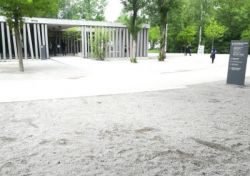Model for sighted and visually impaired visitors

Vorgesehener Standort des Tastmodells gegenüber dem Besucherzentrum
Today, the grounds of Dachau Concentration Camp Memorial Site appear to visitors as a largely abstract space whose significance can only be understood by comparing it to historic photos. Therefore, the planned model is intended to consist of two separate models and to fulfill two key purposes. On the one hand, it will make it possible to compare the former Dachau concentration camp and today’s Memorial Site visually and by touch. The visitors should be able to understand the extent of the former concentration camp. Earth walls block the view of the former SS area of Dachau concentration camp, which is not open to the public. In addition, many residential and industrial facilities were built in the environs of the Memorial Site, so that the topography of Dachau concentration camp can no longer be distinguished in its entirety. For this reason, the model is also intended to enable visitors on the other hand to get their orientation both by sight and by touch at a central point on the grounds of today’s Memorial Site. For this purpose, the historic buildings that have been reconstructed as well as those recently built on today’s grounds would be recreated and labeled in a three-dimensional model.
In order for the model to convey information in keeping with this two-sense approach, the labeling would be in braille as well as in high-contrast, raised letters in German and English. This will ensure that they can be read by people with and without visual impairment, as well as those who cannot read braille.

Planned location of the three-dimensional model across from the Visitors’ Center
